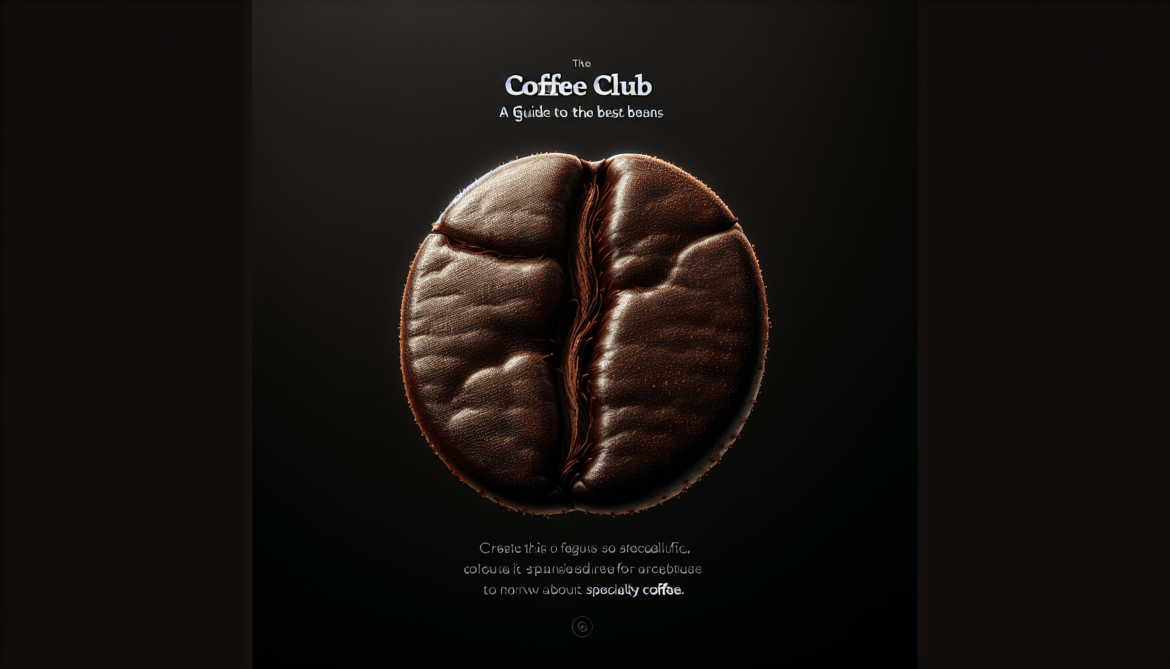If you’re a coffee enthusiast looking to explore the world of specialty beans, then “The Coffee Club: A Guide to the Best Beans” is the article for you. Discovering the perfect coffee beans can take your brewing experience to a whole new level, and this guide will provide you with all the information you need to make informed choices. From understanding different bean types to learning about the various roast levels, this article will be your trusted companion on your journey to finding the best beans that suit your preferences. So grab a cup of your favorite brew, sit back, and let’s embark on this flavorful adventure together.
What is The Coffee Club?
The Coffee Club is a well-known coffee chain that has gained popularity worldwide for its high-quality coffee beans and exceptional customer service. With over 30 years of experience in the industry, The Coffee Club has established itself as a go-to destination for coffee lovers seeking a great cup of joe.
History of The Coffee Club
The Coffee Club was first established in 1989 in Brisbane, Australia. What started as a small, cozy café quickly grew into a thriving franchise with multiple locations across the country. The founders, John Lazarou and Emmanuel Kokoris, envisioned a place where people could come together to enjoy good coffee and delicious food in a relaxed and welcoming environment.
The Coffee Club’s Philosophy
At the heart of The Coffee Club’s philosophy is a commitment to excellence in every aspect of the coffee experience. From sourcing the finest beans to meticulously brewing each cup, The Coffee Club takes pride in delivering a consistently exceptional coffee experience to its customers. They believe that coffee should be more than just a beverage – it should be a moment of pleasure and connection.
Types of Coffee Beans
When it comes to coffee beans, there are two primary types: Arabica and Robusta. Each type has its own unique characteristics and flavors, making them suitable for different preferences and brewing methods. Additionally, coffee blends, which combine different types of beans, offer a harmonious balance of flavors.
Arabica Beans
Arabica beans are known for their smooth and delicate flavors, often described as sweet, fruity, and floral. They are grown at higher altitudes, which contributes to their superior quality and desirable flavor profiles. Arabica beans also contain less caffeine compared to Robusta beans, making them a popular choice for those who prefer a milder coffee experience.
Robusta Beans
Robusta beans, on the other hand, are known for their bold and robust flavors. They have a stronger and more bitter taste compared to Arabica beans and often contain higher caffeine content. Robusta beans are also more resilient, making them easier to cultivate and less prone to diseases. They are commonly used in espresso blends to add depth and crema to the final cup.
Blends
Coffee blends are carefully crafted combinations of different types of beans, designed to offer a well-balanced and complex flavor profile. Blends often use a combination of Arabica and Robusta beans to create a unique taste that satisfies a wide range of palates. They can vary in terms of roast level, origin, and bean ratio, allowing coffee enthusiasts to explore different flavor profiles within a single blend.
How to Choose the Best Coffee Beans
Choosing the best coffee beans can greatly enhance your coffee-drinking experience. Here are some factors to consider when selecting your beans:
Origin
The origin of the coffee beans plays a significant role in determining their flavor profile. Different regions, such as Ethiopia, Colombia, and Brazil, have distinct coffee-growing conditions that result in unique tastes and aromas. Exploring the flavors associated with specific origins can be an exciting journey for coffee lovers.
Roast Level
The roast level of the beans greatly influences their flavor and aroma. Lighter roasts tend to preserve the bean’s original characteristics, highlighting its natural acidity and fruity notes. Medium roasts offer a balanced flavor profile, combining acidity with caramelized sweetness. Dark roasts, on the other hand, offer a richer and smokier taste, with less acidity and more pronounced bitterness.
Freshness
Freshness is key to a great cup of coffee. Look for beans that have been recently roasted as they will retain their flavors and aromas more effectively. Beans often come with a “roasted on” date, allowing you to choose the freshest option available. Additionally, consider buying whole beans and grinding them yourself to maximize freshness.
Certifications
For those concerned with sustainability and ethical practices, consider looking for coffee beans with certifications such as Fair Trade or Rainforest Alliance. These certifications ensure that the coffee beans are sourced from farmers who are paid fair wages and work under environmentally friendly conditions. Choosing certified beans promotes a more sustainable coffee industry.
The Coffee Club’s Bean Selection
The Coffee Club takes great pride in offering an extensive selection of high-quality beans to cater to diverse preferences. Their bean selection encompasses a range of options, including single-origin beans, ethically sourced beans, and organic beans.
Single-Origin Beans
The Coffee Club offers a variety of single-origin beans, sourced from renowned coffee-growing regions around the world. Each origin brings its own distinctive flavor profile, allowing customers to explore the unique tastes associated with different coffee-growing regions. Whether it’s the bright acidity of Ethiopian beans or the chocolaty sweetness of Colombian beans, The Coffee Club’s single-origin beans offer a journey of flavors.
Ethically Sourced Beans
At The Coffee Club, ethical sourcing is a top priority. They partner with coffee farms and cooperatives that prioritize fair trade practices and sustainable farming methods. By choosing ethically sourced beans, The Coffee Club ensures that their customers can enjoy their favorite cup of coffee with the knowledge that it was produced with care for the environment and the well-being of the farmers.
Organic Beans
For those who prefer organic products, The Coffee Club offers a range of organic beans that are grown without the use of synthetic pesticides or fertilizers. These beans are carefully selected to meet organic certification standards, ensuring that they align with a natural and eco-friendly approach to coffee cultivation. Organic beans provide a pure and untainted flavor experience for coffee enthusiasts.
Tips for Storing Coffee Beans
Proper storage is crucial to maintaining the freshness and flavor of your coffee beans. Consider the following tips to ensure your beans retain their quality:
Whole Bean vs Ground Coffee
Whole beans retain their flavors and aromas much better than pre-ground coffee. When beans are ground, they are exposed to oxygen, which accelerates the staling process. To preserve freshness, opt for whole beans and grind them just before brewing.
Proper Storage Containers
Invest in airtight containers specifically designed for storing coffee beans. Avoid using clear or glass containers, as they allow light to degrade the beans. Look for containers with a one-way valve or a vacuum-sealed design to keep oxygen out and maintain freshness.
Avoiding Moisture and Light
Coffee beans are sensitive to moisture and light. Store your beans in a cool, dry place away from sunlight or heat sources like the stove or microwave. Avoid storing them in the refrigerator or freezer, as the moisture and fluctuating temperatures can alter the flavor and create condensation on the beans.
Grinding Coffee Beans
Grinding your coffee beans just before brewing is essential for achieving the best flavor. It allows for greater control over the extraction process and ensures that the coffee grounds are evenly sized for optimal extraction. Here’s everything you need to know about grinding coffee beans:
The Importance of Grinding
Grinding exposes the coffee’s surface area to the brewing water, allowing for the extraction of desirable flavors and aromas. With the right grind size, you can fine-tune the extraction process and achieve the desired balance of flavors in your brewed coffee.
Types of Coffee Grinders
There are two primary types of coffee grinders: blade grinders and burr grinders. Blade grinders use spinning blades to chop the beans into uneven-sized grounds, while burr grinders crush the beans between a moving burr and a stationary surface to produce consistently sized grounds. Burr grinders are generally preferred for their ability to deliver a more precise and consistent grind.
Grind Size for Different Brewing Methods
The ideal grind size varies depending on the brewing method you choose. For French press brewing, a coarse grind is recommended to prevent excessive sediment. For pour-over brewing, a medium grind is suitable to allow water to flow evenly through the filter. Espresso requires a fine grind to enhance the extraction process, while cold brew benefits from a coarse grind to achieve a smooth and mellow flavor.
Brewing Methods
The brewing method you choose greatly affects the taste and characteristics of your coffee. Different methods extract different flavors from the beans, resulting in a variety of coffee experiences. Here are some popular brewing methods:
French Press
French press brewing involves steeping coarse-ground coffee in hot water for a few minutes before pressing down a plunger to separate the grounds from the brewed coffee. This method produces a full-bodied and flavorful cup of coffee with rich aromas and a slightly gritty texture.
Pour Over
Pour-over brewing involves pouring hot water over a filter containing medium-ground coffee, letting it drip through into a container below. This method allows for complete control over the brewing process and produces a clean and bright cup of coffee with a well-defined flavor profile.
Espresso
Espresso is a concentrated coffee extraction method that involves forcing hot, pressurized water through finely ground coffee. This process extracts intense flavors, resulting in a strong and aromatic shot of espresso that serves as the foundation for various espresso-based beverages.
Cold Brew
Cold brew is a slow extraction method that involves steeping coarse-ground coffee in cold water for an extended period of time, typically 12 to 24 hours. The result is a smooth and less acidic cup of coffee with delicate flavors and a refreshing quality. Cold brew concentrate can be diluted with water or paired with milk for a refreshing iced coffee.
The Coffee Club’s Recommended Brewing Techniques
To ensure customers enjoy the best possible coffee experience, The Coffee Club provides some guidelines on brewing techniques. These recommendations include brewing ratios, water temperature, and brewing time.
Brewing Ratios
The Coffee Club suggests a general brewing ratio of 1:16, which means using 1 gram of coffee for every 16 grams of water. However, brewing ratios can be adjusted according to personal taste preferences. Experimenting with different ratios allows coffee enthusiasts to fine-tune the strength and flavor of their brews.
Water Temperature
Water temperature plays a crucial role in coffee extraction. The Coffee Club recommends using water between 195°F and 205°F (90°C-96°C) for optimal extraction. Water that is too hot can result in over-extraction, leading to bitter flavors, while water that is too cool may result in under-extraction, leading to a weak and lacking flavor profile.
Brewing Time
The brewing time varies depending on the brewing method used. The Coffee Club advises steeping French press coffee for about four minutes before pressing down the plunger. Pour-over brewing typically takes around three to four minutes, while espresso extraction should ideally be completed within 25 to 30 seconds to avoid over-extraction.
Flavor Profiles and Tasting Notes
Each coffee variety has its own distinct flavor profile, influenced by factors such as origin, roasting level, and bean type. Understanding flavor profiling and developing your palate can greatly enhance your appreciation of different coffee flavors.
Understanding Flavor Profiling
Flavor profiling involves identifying and describing the specific tastes, aromas, and sensations present in a cup of coffee. Common flavor profiles include fruity, floral, nutty, chocolaty, and earthy notes. By understanding flavor profiling, you can better recognize and appreciate the complex flavors that coffee has to offer.
Developing Your Palate
Developing your palate takes time and practice. Engaging in tasting sessions with a variety of coffee types can help refine your taste buds and discern different flavor characteristics. Pay attention to the specific notes and undertones in each cup, and try to identify the flavors that stand out to you. The more you practice, the better you’ll become at detecting subtle nuances in coffee flavors.
Tasting Notes of Different Coffee Varieties
Different coffee varieties offer a wide range of tasting notes. For instance, Ethiopian coffee is often associated with floral and citrus flavors, while Colombian coffee is known for its nutty and caramel-like notes. Brazilian coffee is often described as having chocolatey and nutty undertones. Exploring different coffee varieties allows you to experience a diverse range of flavors and find your personal favorites.
Best Coffee Beans for Different Preferences
Coffee preferences vary from person to person, with some favoring bold and intense flavors, while others prefer a lighter and more delicate taste. The Coffee Club offers a variety of coffee beans tailored to different preferences.
Rich and Bold
For those seeking a bold and intense coffee experience, The Coffee Club recommends exploring dark roast blends or single-origin beans with chocolatey and smoky undertones. These beans offer a rich and robust flavor profile that stands up well to milk-based drinks or provides a strong kick on their own.
Light and Fruity
If you prefer a lighter and brighter coffee experience, The Coffee Club suggests trying light roast single-origin beans with fruity and floral notes. These beans offer a refreshing and vibrant flavor profile that is especially enjoyable in pour-over or French press brews, which allow their delicate flavors to shine.
Smooth and Balanced
For a well-balanced and versatile coffee option, The Coffee Club recommends medium roast blends or single-origin beans with a combination of nutty and caramel notes. These beans strike a harmony between acidity and sweetness, resulting in a smooth and well-rounded flavor profile that appeals to a wide range of palates.
Decaf Options
For those who want to enjoy the taste of coffee without the effects of caffeine, The Coffee Club offers decaffeinated options. Decaf beans undergo a process to remove most of the caffeine content while preserving the flavor. The Coffee Club’s decaf beans offer a satisfying and flavorful cup without the jolt of energy.
In conclusion, The Coffee Club is not just a coffee franchise, but a brand dedicated to delivering an exceptional coffee experience to its customers. With a wide selection of coffee beans, careful attention to sourcing and freshness, and a commitment to brewing perfection, The Coffee Club ensures that every cup of coffee is a moment of pleasure and connection. Whether you prefer bold and intense flavors, light and fruity notes, or a smooth and balanced profile, The Coffee Club has something to satisfy every coffee lover’s taste buds. So grab your favorite beans, brew a cup, and savor the wonderful world of coffee that The Coffee Club has to offer.



